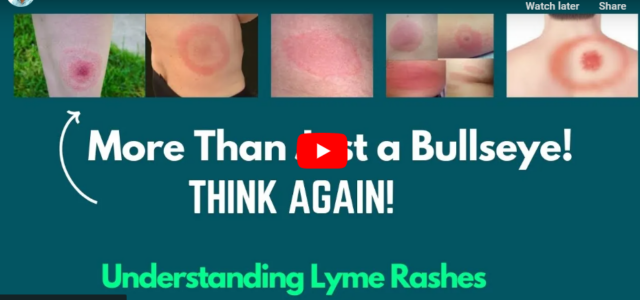Call for your appointment today 914-666-4665 | Mt. Kisco, New York

Many people assume that a Bull’s-eye or erythema migrans (EM) rash is a common manifestation of Lyme disease. And that the lack of a rash confirms a person does not have the disease. This is far from the truth.
EM rash identification remains a challenge because it often takes on a variety of appearances, according to a study by Burlina and colleagues.
“Only 20% of patients with an EM [rash] in the United States present with lesions that have the central clearing of a classic target lesion (“ring-within-a-ring” or “bull’s eye”).¹
Instead, “the majority of EM lesions appear uniformly red or bluish-red in color and lack central clearing.”
Unfortunately, a Lyme disease rash may look like lesions found in other disorders. For instance, patients with Lyme disease may be misdiagnosed as having a cellulitis rash. The treatment for cellulitis is not necessarily effective for Lyme disease.
Furthermore, between 4% and 8% of Lyme disease rashes present with a central blistering. These cases can be misdiagnosed as shingles, a viral infection that causes blistering and is treated with anti-viral medications. Shingles treatment is not effective in treating Lyme disease.
READ MORE: It wasn’t shingles. It was Lyme disease.
Lastly, about 20% of patients have multiple EM rashes at the time of diagnosis due to the Lyme spirochete disseminating to other areas of the body. This presentation can be confused with erythema multiforme or other skin disorders.
In practice, I treat with an antibiotic if there is uncertainty, as the consequences of missing a diagnosis of Lyme disease can be serious. If the rash is questionable, I often treat with antibiotics that would be effective for either Lyme disease or another possible condition. For example, I might treat a patient with a rash that could be cellulitis or Lyme disease with an antibiotic that works for both such as cefuroxime rather than Keflex.
I typically treat these cases longer if Lyme disease is a possibility. Finally, I have also treated patients with a combination of an anti-viral medication (Valtrex) and cefuroxime if I am unsure whether the rash is related to shingles or Lyme disease.
References:
- Burlina PM, Joshi NJ, Mathew PA, Paul W, Rebman AW, Aucott JN. AI-based detection of erythema migrans and disambiguation against other skin lesions. Comput Biol Med. 2020;125:103977.




I am glad you exist. I presented with an EM rash and a black legged tick at my GP, (an NP). She dismissed my concerns and said I had to wait for symptoms. I knew the rash is a symptom, so I tried several other practitioners, and Nurse practitioners, and all said the same thing. The NPs are used as gatekeepers in my Ivy league community in Western NY dominated by a callous hospital system with repeated write ups into the 2010s for keeping separate wing for poor people and gate keeping by labeling poor people as drug addicts to refuse care… It was over three years before I was able to get in front of a full fledged doctor, I presented him with all the info I had and your web URL, and he actually read it! At that point, I had inflammation and heat in my lower spine, and my left knee: he felt it was Lyme arthritis. He started antibiotic treatment, but I went into sepsis a week after the end of a medium course of doxicycline. It took another three years of constant on and off antibiotic cocktails until the symptoms of heat and pain stopped returning shortly after stopping the antibiotic treatment. Needless to say, I was nearly bed bound as my low back had locked up, adhesion in the low back fascia from lack of use, my discs were impinging on my spine according to a neurologist reading my MRI. I did have pre existing injuries to both my knee and low back, which complicated getting treatment as in NYS work related injuries are addressed as “off limits body parts” to deny care due to their choice, even though I was trying to get treatment for Lyme, they would refuse to examine me due to the body part, due to a pre existing work injury, the loophole they use to refuse care these days.
Regardless, it took another three years for the inflammation to resolve in my low back, just in time for my entire medical team to retire after COVID. 2023, over ten years after I first presented with a tick and rash for treatment, an MRI showed a gap between the formerly swollen discs and my cord, no impingement. I however have no intact discs in my lumbar, with the disc at the SI joint, a pre existing injury, now in pieces. I was able to start getting my legs back though, even though in 2023 I could only shuffle….